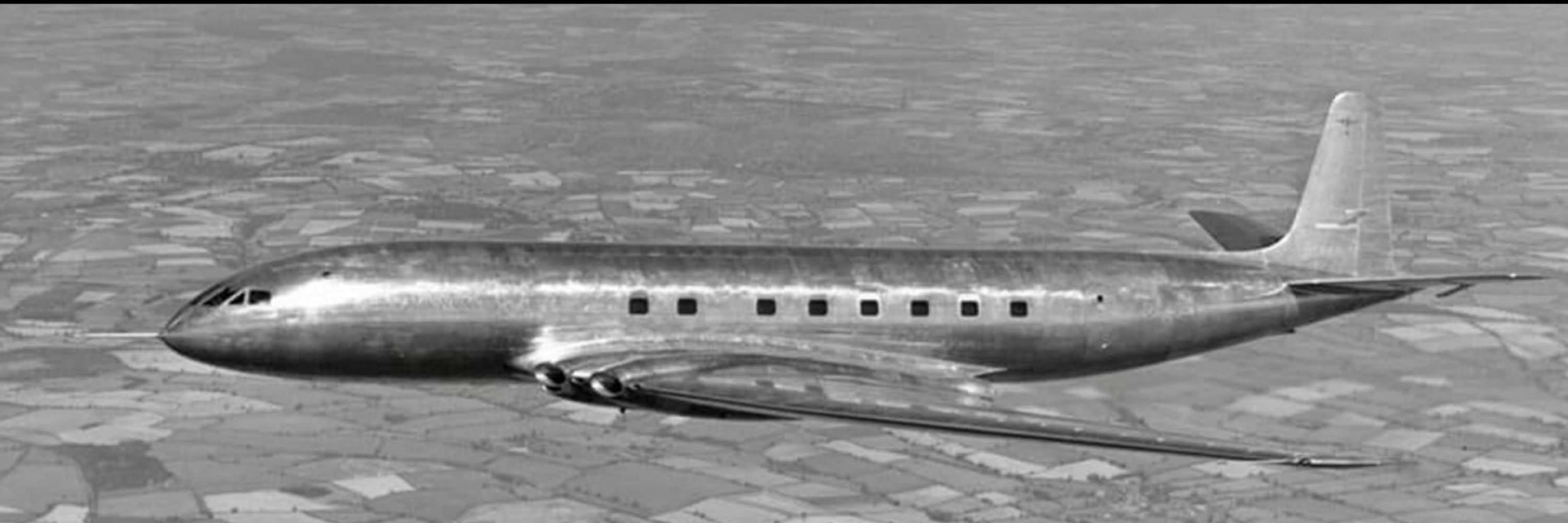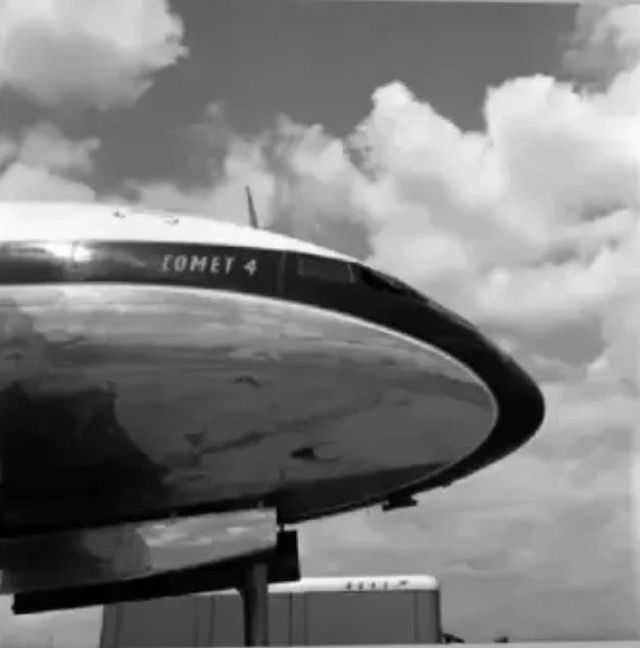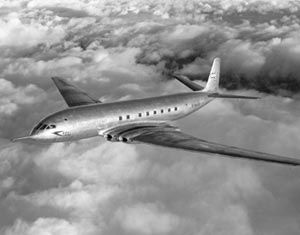
"Today" 9th of November 1980.
The British carrier Dan-Air, flew close to 50 examples of the Comet: acquired on a second-hand basis between the '60s and the '70s.
45 yrs ago, it flew the last passenger-carrying flight of the 4C variant (G-BDIW).

"Today" 9th of November 1980.
The British carrier Dan-Air, flew close to 50 examples of the Comet: acquired on a second-hand basis between the '60s and the '70s.
45 yrs ago, it flew the last passenger-carrying flight of the 4C variant (G-BDIW).
- Air France ordered 3 Comet 1A
- Royal Canadian Air Force ordered 2 Comet 1A, an increased all-up weight + greater fuel capacity



- Air France ordered 3 Comet 1A
- Royal Canadian Air Force ordered 2 Comet 1A, an increased all-up weight + greater fuel capacity
- 25/10/149 the prototype of the C1 did its 1st overseas flight, London 🇬🇧 to Castel Benito (now Tripoli, Libya 🇱🇾)
- 31/10/59 the C 4C had it 1st flight; then entered service with Mexicana in 1960.
It was the most popular Comet variant.


- 25/10/149 the prototype of the C1 did its 1st overseas flight, London 🇬🇧 to Castel Benito (now Tripoli, Libya 🇱🇾)
- 31/10/59 the C 4C had it 1st flight; then entered service with Mexicana in 1960.
It was the most popular Comet variant.
Between London and New York, albeit still requiring a fuel stop at Gander International Airport (Newfoundland) on westward North Atlantic crossings.

Between London and New York, albeit still requiring a fuel stop at Gander International Airport (Newfoundland) on westward North Atlantic crossings.



A total of 12 of the 44-seat Comet 2s were ordered by BOAC for the South Atlantic route.
All but four Comet 2s were allocated to the RAF with deliveries beginning in 1955.

A total of 12 of the 44-seat Comet 2s were ordered by BOAC for the South Atlantic route.
All but four Comet 2s were allocated to the RAF with deliveries beginning in 1955.
The 5-stop flight from London to Johannesburg scheduled for 21h 20m.
In summer '53, 8 Comets left London each week: 3 to Johannesburg, 2 to Tokyo, 2 to Singapore and 1 to Colombo.


The 5-stop flight from London to Johannesburg scheduled for 21h 20m.
In summer '53, 8 Comets left London each week: 3 to Johannesburg, 2 to Tokyo, 2 to Singapore and 1 to Colombo.
...1882 Sir Geoffrey de Havilland was born (Founder)
...1917 John Cunningham was born (Chief Test Pilot)
...1949 Comet's first prototype flew (G-5-1)
...1950 Comet's second prototype flew (G-5-2)
What a day in aviation history.
All linked together indeed.



...1882 Sir Geoffrey de Havilland was born (Founder)
...1917 John Cunningham was born (Chief Test Pilot)
...1949 Comet's first prototype flew (G-5-1)
...1950 Comet's second prototype flew (G-5-2)
What a day in aviation history.
All linked together indeed.
After WWII he was a key figure within the industry, working for De Havilland as Chief Test Pilot and as aviation consultant.



After WWII he was a key figure within the industry, working for De Havilland as Chief Test Pilot and as aviation consultant.
It was a C2 lengthened by 15,5ft / 4.70m, powered by 4 Avon M502 (10,000 lbf / 44 kN), w/ wing pinion tanks and greater capacity/range.
Remained a development variant without fuselage-strengthening modifications and not capable to be fully pressurized.


It was a C2 lengthened by 15,5ft / 4.70m, powered by 4 Avon M502 (10,000 lbf / 44 kN), w/ wing pinion tanks and greater capacity/range.
Remained a development variant without fuselage-strengthening modifications and not capable to be fully pressurized.
However, due to financial difficulties and was eventually absorbed into United Airlines in 1961 and the order never fulfilled.



However, due to financial difficulties and was eventually absorbed into United Airlines in 1961 and the order never fulfilled.
2. On 30/6/1953 Queen Elizabeth, the Queen Mother and Princess Margaret were guests on a special flight of the Comet hosted by Sir Geoffrey and Lady de Havilland.


2. On 30/6/1953 Queen Elizabeth, the Queen Mother and Princess Margaret were guests on a special flight of the Comet hosted by Sir Geoffrey and Lady de Havilland.
Step by step the knowledge acquired led to understand better metal fatigue and its implications.



Step by step the knowledge acquired led to understand better metal fatigue and its implications.
He was the founder of the company De Havilland that produced many of the most stunning aircrafts of the past century: the Moth, the Mosquito, the Comet...


He was the founder of the company De Havilland that produced many of the most stunning aircrafts of the past century: the Moth, the Mosquito, the Comet...
Located in Salisbury Hall (Shenley | London) offers one of the best collection of civil and war planes that marked aviation history forever.
So...happy Bday 🎁🎈🪄🪅🎊🎉



Located in Salisbury Hall (Shenley | London) offers one of the best collection of civil and war planes that marked aviation history forever.
So...happy Bday 🎁🎈🪄🪅🎊🎉
- 16 March '50 C1 prototype set a record: London to Rome with an avg speed of 447mph, returning avg of 453mph thanks to favoureable winds
- 22 March '51 a 2nd prototype of C1 (G-ALZK) was loaned to BOAC for route proving


- 16 March '50 C1 prototype set a record: London to Rome with an avg speed of 447mph, returning avg of 453mph thanks to favoureable winds
- 22 March '51 a 2nd prototype of C1 (G-ALZK) was loaned to BOAC for route proving
BOAC ordered 19 Comet 4s in March 1955, while American operator Capital Airlines ordered 14 Comets in July 1956.

BOAC ordered 19 Comet 4s in March 1955, while American operator Capital Airlines ordered 14 Comets in July 1956.
In 1950 during development tests, the cabin was pushed (litterally) to offer inside a breathable altitude of 8,000 ft (2.400 mt) while cruising outside at a real height of 40,000 ft (12.100 mt)

In 1950 during development tests, the cabin was pushed (litterally) to offer inside a breathable altitude of 8,000 ft (2.400 mt) while cruising outside at a real height of 40,000 ft (12.100 mt)
Geoffrey Raoul de Havilland Jr., OBE was born on 18 February 1910, he was a British test pilot.
He first flew at the age of 8 months, carried in his mother's arms in a plane piloted by his father Sir de Havilland Sr.

Geoffrey Raoul de Havilland Jr., OBE was born on 18 February 1910, he was a British test pilot.
He first flew at the age of 8 months, carried in his mother's arms in a plane piloted by his father Sir de Havilland Sr.
First pieces of wreckage were discovered on 12/2.
A forensic reconstruction stated: no apparent fault in the aircraft was found.
Comet flights resumed on 23 March.

First pieces of wreckage were discovered on 12/2.
A forensic reconstruction stated: no apparent fault in the aircraft was found.
Comet flights resumed on 23 March.
Out of all the Brabazon designs, the DH 106 was seen as the riskiest both in terms of introducing untried design elements and for the financial commitment involved.

Out of all the Brabazon designs, the DH 106 was seen as the riskiest both in terms of introducing untried design elements and for the financial commitment involved.


The earliest production aircraft, registered G-ALYP ("Yoke Peter"), first flew "today" and was subsequently lent to BOAC for development flying by its Comet Unit.
9/1/2000:
Sir Arnold Alexander Hall died.
He led the RAE-team that discovered the cause of Comet 1 jet airliner crashes.



The earliest production aircraft, registered G-ALYP ("Yoke Peter"), first flew "today" and was subsequently lent to BOAC for development flying by its Comet Unit.
9/1/2000:
Sir Arnold Alexander Hall died.
He led the RAE-team that discovered the cause of Comet 1 jet airliner crashes.

